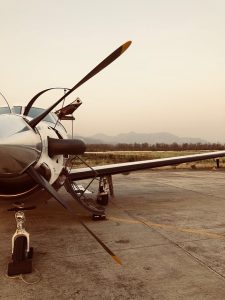
Not all aircraft propellers are the same. While most pilots are familiar with fixed pitch and constant speed, there are other types available, such as climb and cruise.
Climb and cruise propellers are both classified as fixed-pitch propellers. Like all fixed-pitch propellers, they have a static blade angle that can’t be adjusted. Climb and cruise, however, are two different types of propellers with their own unique characteristics.
What Is a Climb Propeller?
A climb propeller is a type of fixed-pitch propeller that’s set at a low or flat blade angle. As the name suggests, they excel at climbing. Airplanes that spend a lot of time taking off or climbing often feature a climb propeller.
With a climb propeller, the engine can spin faster. This allows for more thrust at otherwise slow speeds, which improves climbing performance.
What Is a Cruise Propeller?
A climb propeller is a type of fixed-pitch propeller that’s set at a high or steep angle. Manufacturers create them with a steeper angle than that of climb propellers. As a result, cruise propellers are better suited for cruising.
Differences Between Climb and Cruise Propellers
Neither climb nor cruise propellers have an adjustable blade angle. Rather, they are both fixed-pitch propellers. The difference between climb and cruise propellers lies in their blade angle. As previously mentioned, climb propellers have a low or flat blade angle, whereas cruise propellers have a high or steep blade angle.
With a low or flat blade angle, climb propellers produce less drag. The end result is higher engine RPMs, which translates into increased performance during takeoffs and when climbing.
Cruise propellers don’t perform as well during takeoffs and when climbing. However, they are very effective at cruising. They produce more drag, which reduces engine RPMs. While lower RPMs makes climbing more difficult, it improves cruising efficiency. Airplanes with a cruise propeller typically burn less fuel when cruising than those with a climb propeller.
Cruise propellers also allow for faster cruising speeds. Airplanes with a cruising propeller typically cruise about 10% to 15% faster than their counterparts with a climb propeller. The combination of increased fuel efficiency and faster speeds when cruising makes them a popular choice.
In Conclusion
Climb and cruise propellers aren’t the same. Climb propellers deliver better takeoff performance and steeper ascent, making them ideal for short fields, mountainous terrain or operations at higher elevations. Cruise propellers, on the other hand, trade off climb performance for better speed and fuel efficiency once you’re in level flight. While both are fixed-pitch and non-adjustable, their distinct blade angles shape the way your aircraft performs.



